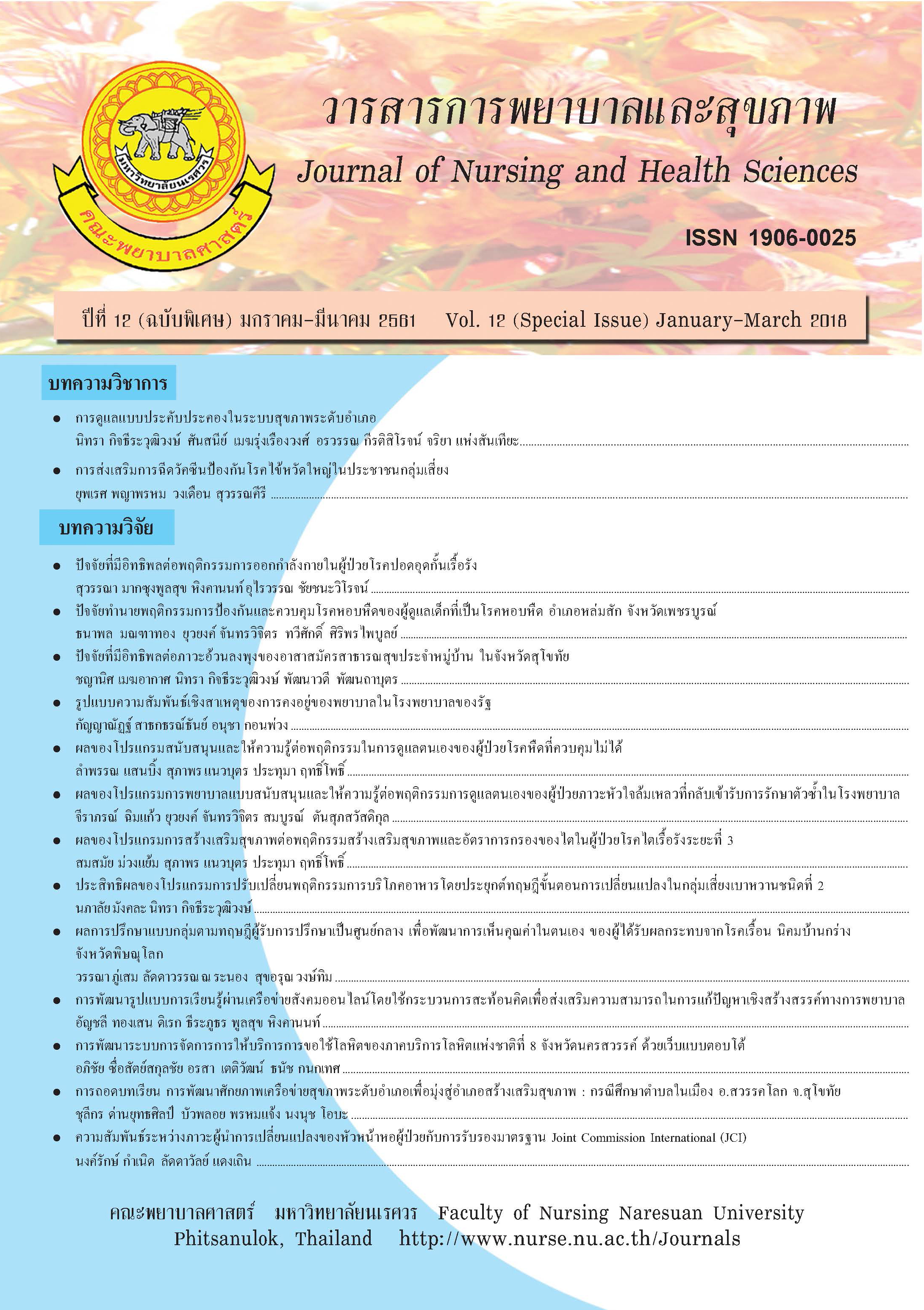ความสัมพันธ์ระหว่างภาวะผู้นำการเปลี่ยนแปลงของหัวหน้าหอผู้ป่วยกับการรับรองมาตรฐาน
Main Article Content
บทคัดย่อ
การวิจัยครั้งนี้เป็นการวิจัยเชิงพรรณนาเพื่อศึกษา 1) ภาวะผู้นำการเปลี่ยนแปลงของหัวหน้าหอผู้ป่วย ตาม การรับรู้ของพยาบาลวิชาชีพ 2) การรับรองมาตรฐาน Joint Commission International ( JCI ) 3) ความสัมพันธ์ ระหว่างภาวะผู้นำการเปลี่ยนแปลงของหัวหน้าหอผู้ป่วยกับการรับรองมาตรฐาน JCI กลุ่มตัวอย่างคือพยาบาล วิชาชีพในเครือโรงพยาบาลเอกชนขนาดใหญ่ 31 แห่ง จำนวน 299 คน เครื่องมือที่ใช้เก็บรวบรวมข้อมูลคือ แบบสอบถาม ประกอบด้วย 3 ส่วนคือ ข้อมูลส่วนบุคคล ภาวะผู้นำการเปลี่ยนแปลงของหัวหน้าหอผู้ป่วย ตามการรับรู้ของพยาบาลวิชาชีพที่ปฏิบัติงานในเครือโรงพยาบาลเอกชนขนาดใหญ่และการได้รับการรับรอง มาตรฐาน JCI ทดสอบค่าความเที่ยงของแบบสอบถาม ส่วนที่ 2 โดยคำนวณจากสูตรสัมประสิทธิ์แอลฟา ของครอนบาค (Cronbach’s alpha coefficient) เท่ากับ 0.96 วิเคราะห์ข้อมูลโดยใช้การแจกแจง ความถี่ (Frequency) ร้อยละ (Percentage) ค่าเฉลี่ย (Mean) และส่วนเบี่ยงเบนมาตรฐาน (Standard Diviation) และวิเคราะห์ความสัมพันธ์ โดยใช้สถิติทดสอบ Multinomial Logistic Regression ผลการวิจัยพบว่า 1) ภาวะผู้นำการเปลี่ยนแปลงของหัวหน้าหอผู้ป่วยโดยรวมอยู่ระดับมาก ( = 4.13 , S.D. = 0.55 ) 2) เครือโรงพยาบาลเอกชนขนาดใหญ่แห่งหนึ่ง ส่วนใหญ่ยังไม่เคยผ่านการประเมินและรับรอง มาตรฐาน JCI ร้อยละ 66.8 และผ่านการประเมินและรับรองมาตรฐาน JCI ร้อยละ 33.2 และ 3) ภาวะผู้นำ การเปลี่ยนแปลงโดยรวม มีความสัมพันธ์กับการรับรองมาตรฐาน JCI อย่างมีนัยสำคัญทางสถิติ (p < .01)
Article Details
เอกสารอ้างอิง
โรงพยาบาลในประเทศไทย:สถานการณ์
และแนวโน้ม.กรุงเทพฯ. ภาควิชาบริหารงาน
สาธารณสุข คณะสาธารณสุข มหาวิทยาลัยมหิดล.
จิรุตม์ ศรีรัตนบัลล์. (2541). การรับรองโรงพยาบาลใน
สหรัฐอเมริกา: เอกสารประกอบการประชุม
แลกเปลี่ยนประสบการณ์ระหว่างโรงพยาบาล
ในโครงการพัฒนาและรับรองคุณภาพโรงพยาบาล.
กรุงเทพฯ: โรงพยาบาลบำรุงราษฎร์.
เฉลิม หาญณรงค์.(2551).ความเหมือนและความแตกต่าง
ของHA และ JCI. Journal of safety and
health ,2 (5),49-51.
ทิพย์รัตน์ กลั่นสกุล. ( 2547).ความสัมพันธ์ระหว่างภาวะ
ผู้นำการเปลี่ยนแปลงของหัวหน้าหอผู้ป่วย
การมีส่วนร่วมในงานกบประสิทธิผลของทีม
การพยาบาล ตามการรับรู้ของพยาบาล ประจำการ
โรงพยาบาลทั่วไป เขตภาคกลาง . วิทยานิพนธ์
พย.ม.,คณะพยาบาลศาสตร์ จุฬาลงกรณ์
มหาวิทยาลัย.
ทัศนา บุญทอง. (2542). ปฏิรูประบบบริการการ
พยาบาลที่สอดคล้องกับระบบบริการสุขภาพ
โดยที่พึงประสงค์ในอนาคต.กรุงเทพฯ: ศิริยอด
การพิมพ์.
บริษัท กรุงเทพดุสิตเวชการ จำกัดมหาชน. (2556).
รายงานประจำปี2556.กรุงเทพฯ: กรุงเทพดุสิต
เวชการ.
พูลสุข หิงคานนท์.(2554).ภาวะผู้นำทางการพยาบาล.
พิษณุโลก: ดาวเงินการพิมพ์.
พิริยลักษณ์ ศิริศุภลักษณ์.( 2556).การจ้างงานและ
สภาพการทำงานในต่างประเทศตามการรับรู้
ของพยาบาลไทย. กรุงเทพฯ: วิทยาลัยพยาบาล
สภากาชาดไทย.
โรงพยาบาลเอกชนในพิษณุโลก. (2558). แผนงาน
ประจำปี2558. พิษณุโลก.
วีระชาติ อินทร์โต. (2557).ความสัมพันธ์ระหว่าง
ภาวะผู้นำการเปลี่ยนแปลงของผู้อำนวยการ
โรงพยาบาลส่งเสริมสุขภาพตำบลกับระดับ
การพัฒนาคุณภาพหน่วยบริการปฐมภูมิ
โรงพยาบาลส่งเสริมสุขภาพตำบล จังหวัด
ชัยนาท.วิทยานิพนธ์ พย.ม.,มหาวิทยาลัย
มหาวิทยาลัยนเรศวร,พิษณุโลก.
ไทยรัฐออนไลน์.(2556). การยกเว้นวีซ่า 6 ชาติอาหรับ
ที่รักษาพยาบาลในไท: ไทยรัฐเชียร์ไทยแลนด์.
เข้าถึงได้ที่http://WWW.thairath.co.th/content/
edu/324754. เมื่อ 5 มกราคม พ.ศ.2558.
สำนัการพยาบาล . (2549). หน้าที่ความรับผิดชอบหลัก
และสมรรถนะพยาบาลวิชาชีพ. นนทบุรี:
สำนักการพยาบาล กรมการแพทย์ กระทรวง
สาธารณสุข.
อรทัย รุ่งวชิรา.(2547).ความสัมพันธ์ระหว่างภาวะผู้นำ
การเปลี่ยนแปลงกับการดำเนินกิจกรรม
พัฒนาคุณภาพของหัวหน้าหอผู้ป่วยตามการ
รับรู้ของพยาบาลประจำการ.วิทยานิพนธ์ พย.ม.,
มหาวิทยาลัยบูรพา,ชลบุรี.
อัญชลี ดวงอุไร.(2545). ความสัมพันธ์ระหว่างปัจจัย
ส่วนบุคคล ภาวะผู้นำของหัวหน้าหอผู้ป่วย
การรับรู้ความชัดเจนในนโยบายขององค์การ
กับการมีส่วนร่วมในกิจกรรมพัฒนาคุณภาพ
ของพยาบาลประจำการ โรงพยาบาลสังกัด
กระทรวงกลาโหม. วิทยานิพนธ์ พย.ม.,
คณะพยาบาลศาสตร์ จุฬาลงกรณ์มหาวิทยาลัย.
Bass, B.M., and Avolio, B.J.(1994). Improving
organizational effectiveness through transformation
leadership. Thousand Oaks: Sage.
Bass, M. M. (1985). Leadership and Performance
Beyond Expectations: New York.
Joint Commission International.(2011).Joint
Commission International Accreditation
Standards for Hospitals. 4th eds. Oakbrook
Terrace: Joint Commission Resources.
World Health Organization (WHO). (1984). Health
Promotion: A discussion document on the
concept and principle. World Health
Organization. Copenhegen: Denmark.
World Health Organization (WHO). (1998). The world
health report 1998-Life in the 21st century: a
vision for all World Health Organization.
Geneva: Switzerland.


